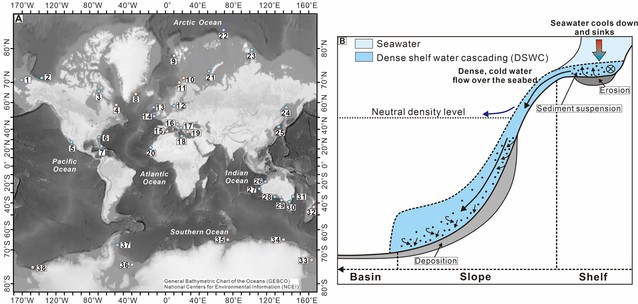Nan Wu , , , , ,
a State Key Laboratory of Marine Geology, Tongji University, 1239 Siping Road, Shanghai, 200092, China
b Minderoo-UWA Deep-Sea Research Centre, School of Biological Sciences and UWA Oceans Institute, The University of Western Australia, Perth, WA 6009, Australia
c Center for Sustainable Geoscience and Outreach (CSGO), Universitas Pertamina, Jakarta, 12220, Indonesia
d Shell Research, Shell Centre, London, SE1 7NA, United Kingdom
Abstract:Dense shelf water cascade (DSWC) is a common oceanographic phenomenon on many continental shelves. Previous studies indicate that the DSWC could shape seabed physiography and carry seawater, sediment, and organic carbon a long distance from the continental shelf to the basin floor. However, it remains enigmatic how these DSWC's interact with seabed geomorphology and travel long distances from the shallow to deep marine environments. In this study, we employed high-resolution multibeam bathymetry, 2D and 3D seismic reflection, core description, and sediment grain size data from the Gippsland Basin, southeast offshore Australia. The continental shelf of the central Gippsland Basin stores sediment supplied by the along-shelf transported DSWC. By calculating the sediment motion threshold, we demonstrate that the DSWC is capable of entraining sediment from, and forming dense bottom nepheloid layers above, the seabed. Seismic reflection data reveal that cyclic steps are common on the shelf and slope, indicating a downslope-transported, supercritical current-dominated environment. Core observation and grain size analyses reveal that coarse-grained, Ta-typed turbidites are the major facies, indicating the presence of high-intensity downslope-traversing turbidity currents. Thus, supercritical turbidity currents are the dominant sedimentary process in the central Gippsland Basin. We illuminate that DSWC can interact with pre-existing seabed bathymetry created by a buried submarine landslide, resuspending sediment and igniting downslope-transported turbidity currents. The presence of numerous cyclic steps indicates that the turbidity current can evolve into a supercritical regime upon ignition, leaving complex seabed geomorphology and allowing the forming currents to travel across the shelf and extend more than 80 km down the lower slope. As revealed by our literature review, we imply that the transformation of DSWC into turbidity currents should be a common sedimentary process on outer continental shelves globally, significantly sculpting the seabed morphology and facilitating sediment and other marine particles transportation from shallow to deep sea.
Full Article:https://www.sciencedirect.com/science/article/pii/S0012821X23005587



